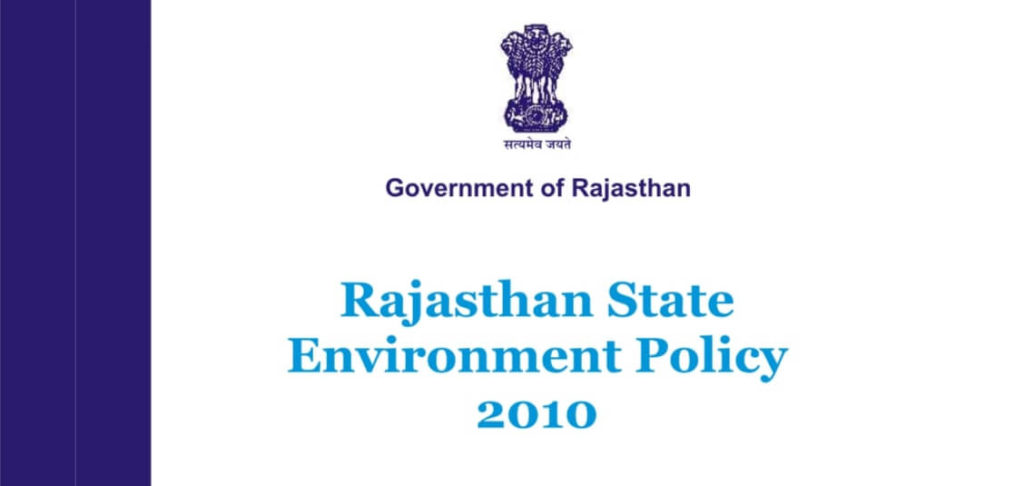Rajasthan Environment Policy 2010 identifies the key environmental challenges and outlines strategies and actions to address them. The document is based on an analysis of the state-specific issues, the natural resource constraints from which these emerge, and their overall implications for the environment.
Above all, it is intended to be a guide to action, and accordingly provides inputs for a State Environment Mission, supported by Task Forces with specific agenda and action plan, and institutional arrangements for implementation of the proposed measures.
Key Environmental Challenges in Rajasthan
Rajasthan faces several environmental challenges that it must address to ensure continued economic growth that is sustainable and equitable. These include:
- Increasing demand for water.
- Mineral reserves in forest areas which the forest policy has restricted from being exploited.
- Abatement of pollution in the face of industrialization and rapid urban growth.
- Population growth and the continual flow of migrants to the cities.
- Strike a balance between the exploitation of forests for products of economic value (such as food, medicines, timber), and conservation efforts which seek to maintain the natural processes that sustain biodiversity.
- Strategy for providing cooking and lighting energy for the rural population.
- Development of the tourism industry also poses a challenge, as it exerts considerable pressure on civic amenities (including water and sanitation and transport), land use, wildlife and forests, and the socio-economic fabric of the State.
- Climate change is of increasing concern not only at the national level but for the State governments as well.
- The nexus between poverty and environment.
- The environment policy must support research and development activities that promote innovation and provide technological alternatives, as well as insights for policy making and regulation.
Objectives of Rajasthan Environment Policy 2010
The objectives and principles of the State Environment Policy are the same as those on which the National Environment Policy, 2006 is founded. Broadly, the SEP aims to:
- Conserve and Enhance Environmental Resources by protecting critical ecosystems and natural and man-made heritage, ensuring equitable access to environmental resources for all sections of society, ensuring judicious use of these resources to assure inter-generational equity, and ensuring their efficient use to maximize productivity and minimize environmental degradation.
- Assure Environmental Sustainability of Key Economic Sectors by integrating environmental concerns into policies, plans, programs, and projects for economic and social development, so that these do not erode the very resource base on which they are dependent
- Improve Environmental Governance and Build Capacity by assuring transparency, rationality, accountability, time and cost effectiveness, participation, and regulatory independence in the process of environmental management and regulation. The policy should also ensure higher resource flow for environmental conservation and promote beneficial multi stakeholders partnership.
Principles of Rajasthan Environment Policy 2010
The basic principles guiding the strategic interventions of Rajasthan Environment Policy 2010 are the same as those documented in the National Environment Policy, 2006, that is:
- Human beings are at the center of concerns for sustainable development and are entitled to a healthy and productive life in harmony with nature.
- The right to development must be fulfilled with equity for present and future generations across all sections of society.
- Environmental protection is an integral part of the development process and cannot be considered in isolation from it.
- Where there are credible threats to key environmental resources, the ‘precautionary approach’ shall be followed and lack of full scientific certainty will not be used as a reason for not taking mitigatory action.
- Production and consumption activities will aim for economic efficiency by assigning economic value to the cost of environmental services, ensuring that polluters pay for the cost of pollution, minimizing wasteful use and consumption of natural resources, and minimizing institutional costs and delays in environmental management.
- Entities with ‘Incomparable’ value (such as unique historical monuments, charismatic species of fauna and flora, unique landscapes) must be preserved at any cost as damage to these cannot be compensated in terms of money or conventional goods and services.
- The environmental policy must be guided by the principles of equity in all its facets, i.e. ‘procedural equity’ relating to fair rules for allocation of entitlements and obligations, ‘end-result equity’ relating to fair distribution of outcomes, ‘intra-generational equity’ within societies, and ‘inter-generational’ equity relating to justice between generations.
- Civil liability may be used in addition to criminal liability as a deterrent to environmentally harmful actions, and for compensation to the victims of environmental damage.
- The State is the trustee of all natural resources, and must enable their public use while protecting the legitimate interest of a large number of people.
- Decentralization of powers from a Central Authority to State and Local Authorities could empower the public authorities to more effectively address local environmental concerns.
- Environmental concerns must be integrated into sectoral policy making and policy research, and linkages must be strengthened among the various agencies charged with implementation of environmental policies at the central, State, and Local Self-Government levels.
- Environmental standards must reflect the economic and social development situation in which they are to be applied, and must be based on considerations of risk to human health, risks to other environmental entities, technical feasibility, costs of compliance, and other strategic considerations.
- It is preferable (and often cheaper) to prevent environmental damage from occurring, rather than attempting to restore after degradation. (xiv) If endangered species and natural ecosystems of special importance to sustaining life, providing livelihoods, and general well being are threatened by a developmental activity, environmental offsetting measures must be undertaken to restore as nearly as feasible the lost environmental services to the affected populations.
Strategies and Actions
The set of strategies and actions to redress the key environmental problems of the State are covered under three broad areas:
- Conserving and enhancing environmental resources;
- Assuring sustainability of key economic sectors; and
- Improving environmental governance and building capacity.
Water, land, air, forests and biodiversity are key resources that must be conserved and enhanced. At the same time, vulnerability assessment and adaptation measures should be undertaken in the vulnerable sectors to mitigate the impacts of climate change, especially on the poor sections of society.
Policy Review and Implementation
As development imperatives in the State and their environmental implications change, new environmental priorities will emerge over time. Changes in national and global environmental regimes will also affect state level environmental issues. Therefore, the State Environmental Policy needs to be a dynamic document, which is subjected to periodic review and aligned with new knowledge and developments in the forthcoming years.
To assure implementation of this SEP, a State Environment Mission has been constituted, which will be supported by Task Forces with specific agenda and action plan, and institutional arrangements and resources for implementation of the proposed measures. Details with respect to the State Environment Mission are provided in a separate document.
- Rajasthan Environment Policy 2010 – Download PDF


